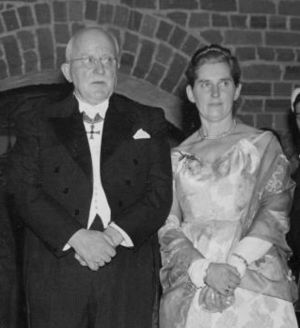Magda Staudinger facts for kids
Quick facts for kids
Magda Staudinger
|
|
|---|---|

Hermann and Magda Staudinger in Stockholm in 1953
|
|
| Born |
Magda Voita
17 August 1902 Elva, Governorate of Livonia, Russian Empire
(now Elva, Estonia) |
| Died | 21 April 1997 (aged 94) |
| Nationality | Latvian |
| Other names | Magda Woit Staudinger, Magda Štaudingere, Magda Štaudingere-Voita |
| Alma mater | University of Berlin University of Latvia |
| Occupation | biologist/botanist |
| Years active | 1927–1976 |
| Spouse(s) | Hermann Staudinger |
Magda Staudinger (Latvian: Magda Štaudingere) was a Latvian scientist. She was born on August 17, 1902, and passed away on April 21, 1997. Magda was a biologist and botanist.
She worked with her husband, Hermann Staudinger, to study very large molecules called macromolecules. They also explored how these giant molecules are used in living things. When her husband won the Nobel Prize in Chemistry, he recognized her important help. After he passed away, Magda published seven books of his scientific work. She received a special medal from the Latvian Academy of Sciences for her contributions to science.
Contents
Biography
Early Life and Education
Magda Voita was born in Elva, Estonia, on August 17, 1902. Her father, Oskars Voits, was a doctor. As a child, Magda lived in Saint Petersburg, Russia. She traveled a lot through Germany, Hungary, and Switzerland. Because of her travels, she became fluent in English, French, German, and Russian. She was also a very good pianist and violinist.
Magda decided to study at the University of Berlin in Germany. She studied plants with a professor named Gottlieb Haberlandt. In 1925, she earned her degree in natural sciences. She then continued her studies at the University of Latvia in Riga. In 1927, she earned her PhD.
Working with Macromolecules
In 1927, Magda married Hermann Staudinger. He would later win a Nobel Prize for his work. They moved to Freiburg, Germany, where Hermann took a job at Freiburg University. Magda met Hermann while she was studying algae cell membranes. Hermann had recently published his research on cellulose. From then on, they started working together on macromolecules.
Magda Staudinger spent many years studying macromolecules. She looked at their chemical structure. In the 1940s, she began applying her knowledge of macromolecules to biology. She conducted experiments on living cells starting in 1945. In 1946, Hermann started a science journal called Makromolekulare Chemie. Magda was part of the team that decided which articles would be published.
When Hermann received the Nobel Prize in Chemistry, he openly thanked Magda for her help. Between 1937 and 1956, Magda wrote 30 scientific papers. These papers were about the size of molecules and how fibers and colloids look under a microscope. After her husband's death, she edited and published seven books of his collected works. This happened between 1969 and 1976.
Helping Women in Science
After Hermann passed away in 1965, Magda became the president of the International Federation of University Women. She held this position until 1968. She worked hard to get more recognition for women in science. In the 1970s, she joined UNESCO. This is a United Nations organization that promotes education, science, and culture.
From 1970 to 1975, she was the president of UNESCO's German Science Commission. She also helped start the UNESCO Biosphere program. This program focuses on protecting different parts of Earth's environment.
Legacy and Awards
In 1990, Magda Staudinger became an honorary member of the Latvian Academy of Sciences. The next year, in 1991, she created a fund. This fund helps students studying biology, chemistry, and medicine in Latvia. In 1995, she set up another fund called the Magda and Hermann Staudinger Fund. This fund helps retired members of the Latvian Academy of Sciences. In 1996, she received the Grand Order of the Latvian Academy of Sciences Medal.
Magda Staudinger passed away in Freiburg, Germany, on April 21, 1997. She was buried next to her husband in the Hauptfriedhof Freiburg Cemetery.
See also
 In Spanish: Magda Staudinger para niños
In Spanish: Magda Staudinger para niños

